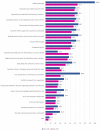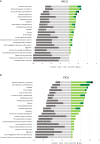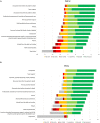End-of-Life Care Related Distress in the PICU and NICU: A Cross-Sectional Survey in a German Tertiary Center
- PMID: 34631614
- PMCID: PMC8498332
- DOI: 10.3389/fped.2021.709649
End-of-Life Care Related Distress in the PICU and NICU: A Cross-Sectional Survey in a German Tertiary Center
Abstract
Objective: To investigate and compare nurses' perceived care-related distress and experiences in end-of-life situations in neonatal and pediatric intensive care units. Study design: Single-center, cross-sectional survey. Administration of an anonymous self-report questionnaire survey to nurses of two tertiary neonatal intensive care units (NICUs), and two tertiary pediatric intensive care units (PICUs) in Berlin, Germany. Results: Seventy-three (73/227, response rate 32.2%) nurses completed surveys. Both, NICU (32/49; 65.3%) and PICU (24/24; 100.0%) nurses, reported "staffing shortages" to be the most frequent source of distress in end-of-life situations. However, when asked for the most distressing factor, the most common response by NICU nurses (17/49) was "lack of clearly defined and agreed upon therapeutic goals", while for PICU nurses (12/24) it was "insufficient time and staffing". No significant differences were found in reported distress-related symptoms in NICU and PICU nurses. The interventions rated by NICU nurses as most helpful for coping were: "discussion time before the patient's death" (89.6%), "team support" (87.5%), and "discussion time after the patient's death" (87.5%). PICU nurses identified "compassion" (98.8%), "team support", "personal/private life (family, friends, hobbies)", and "discussion time after the patient's death" (all 87.5%) as most helpful. Conclusions: Distress-related symptoms as a result of end-of-life care were commonly reported by NICU and PICU nurses. The most frequent and distressing factors in end-of-life situations might be reduced by improving institutional/organizational factors. Addressing the consequences of redirection of care, however, seems to be a more relevant issue for the relief of distress associated with end-of-life situations in NICU, as compared to PICU nurses.
Keywords: children; intensive care unit; newborn; nurse; palliative care; stress.
Copyright © 2021 Garten, Danke, Reindl, Prass and Bührer.
Conflict of interest statement
The authors declare that the research was conducted in the absence of any commercial or financial relationships that could be construed as a potential conflict of interest.
Figures



Similar articles
-
End-of-life opioid administration on neonatal and pediatric intensive care units: nurses' attitudes and practice.Eur J Pain. 2011 Oct;15(9):958-65. doi: 10.1016/j.ejpain.2011.03.009. Epub 2011 Apr 30. Eur J Pain. 2011. PMID: 21531155
-
End-of-Life Decision-Making in Pediatric and Neonatal Intensive Care Units in Croatia-A Focus Group Study among Nurses and Physicians.Medicina (Kaunas). 2022 Feb 7;58(2):250. doi: 10.3390/medicina58020250. Medicina (Kaunas). 2022. PMID: 35208575 Free PMC article.
-
Sources of distress for physicians and nurses working in Swiss neonatal intensive care units.Swiss Med Wkly. 2017 Aug 3;147:w14477. doi: 10.4414/smw.2017.14477. eCollection 2017. Swiss Med Wkly. 2017. PMID: 28804867
-
The relationship between providing neonatal palliative care and nurses' moral distress: an integrative review.Adv Neonatal Care. 2014 Oct;14(5):322-8. doi: 10.1097/ANC.0000000000000100. Adv Neonatal Care. 2014. PMID: 25022749 Review.
-
The Use and Impact of Diaries in PICUs and Neonatal ICUs: A Scoping Review.Pediatr Crit Care Med. 2023 Feb 1;24(2):e84-e90. doi: 10.1097/PCC.0000000000003122. Epub 2022 Dec 13. Pediatr Crit Care Med. 2023. PMID: 36521187
Cited by
-
Nurses' beliefs in the care of newborns at the end of life in the neonatal intensive care unit.Rev Esc Enferm USP. 2024 Oct 28;58:e20240065. doi: 10.1590/1980-220X-REEUSP-2024-0065en. eCollection 2024. Rev Esc Enferm USP. 2024. PMID: 39475391 Free PMC article.
-
Palliative care practice and moral distress during COVID-19 pandemic (PEOpLE-C19 study): a national, cross-sectional study in intensive care units in the Czech Republic.Crit Care. 2022 Jul 19;26(1):221. doi: 10.1186/s13054-022-04066-1. Crit Care. 2022. PMID: 35854318 Free PMC article.
References
LinkOut - more resources
Full Text Sources

